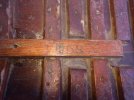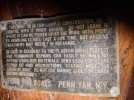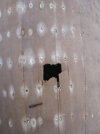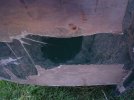TedHJ
Owner of a Penn Yan 9' Aerodinghy
First time on this forum, so I hope I'm in the right place. I'm based in the UK.
I realise that my dinghy is not a canoe, but it seems to be constructed in a similar fashion and therefore I hope you can advise..

I'd love as much advice as I can get, particularly from anyone who has restored a similar dinghy with a canvas cover and even better, if they are based in the UK and can advise on where to get the necessary tools and supplies.
History: I purchased this boat from a neighbour in Henley-on-Thames UK about 30 years ago. Had a lot of fun rowing it up and down the river, but one rather drunken evening managed to put a couple of holes in it. It went in the garage, and then I got married, had kids, a busy job and it has lain there ever since. I took the (I think) green canvas covering off it, to uncover how bad the holes were and assess the damage, but now realise that to restore it, I have a bit of a project.
Circumstances: Now, I'm semi-retired, have a nice big workshop, and a basic understanding of woodwork (and lots of time on various boats of different sizes), but I have never worked on a vessel like this. On my farm I also have a couple of experienced cabinet makers / joiners, so they can lend some expertise (I hope)..
Penn Yan: A few years ago I was in touch with TJ from Penn Yan, he suggested sending me some canvas, paint, tools and instructions, but I didn't get the feeling he was happy to ship to the UK (understandable!) and I was wondering if the canvas and paint could be bought locally. I'm more than happy to pay for stuff being shipped over if needed, or instructions etc. but hope that heavy / trick stuff might be sourced in UK.
Some people looking at the dinghy have suggest that I simply varnish it, rather than recover with canvas, others that I apply GRP, but to me that doesn't sound right and more of a 'quick fix'. If recanvassing for a novice is possible, I'd like to give it a go.

I realise that my dinghy is not a canoe, but it seems to be constructed in a similar fashion and therefore I hope you can advise..
I'd love as much advice as I can get, particularly from anyone who has restored a similar dinghy with a canvas cover and even better, if they are based in the UK and can advise on where to get the necessary tools and supplies.
History: I purchased this boat from a neighbour in Henley-on-Thames UK about 30 years ago. Had a lot of fun rowing it up and down the river, but one rather drunken evening managed to put a couple of holes in it. It went in the garage, and then I got married, had kids, a busy job and it has lain there ever since. I took the (I think) green canvas covering off it, to uncover how bad the holes were and assess the damage, but now realise that to restore it, I have a bit of a project.
Circumstances: Now, I'm semi-retired, have a nice big workshop, and a basic understanding of woodwork (and lots of time on various boats of different sizes), but I have never worked on a vessel like this. On my farm I also have a couple of experienced cabinet makers / joiners, so they can lend some expertise (I hope)..
Penn Yan: A few years ago I was in touch with TJ from Penn Yan, he suggested sending me some canvas, paint, tools and instructions, but I didn't get the feeling he was happy to ship to the UK (understandable!) and I was wondering if the canvas and paint could be bought locally. I'm more than happy to pay for stuff being shipped over if needed, or instructions etc. but hope that heavy / trick stuff might be sourced in UK.
Some people looking at the dinghy have suggest that I simply varnish it, rather than recover with canvas, others that I apply GRP, but to me that doesn't sound right and more of a 'quick fix'. If recanvassing for a novice is possible, I'd like to give it a go.




